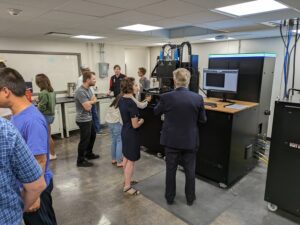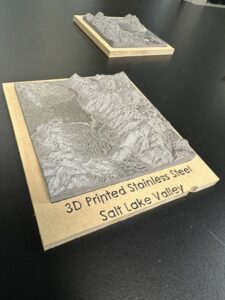 The University of Utah has a new laser powder bed fusion (LPBF) 3D printer, which was unveiled at a ribbon-cutting ceremony on September 11th. The machine uses a laser to locally melt metal powder in a layer-by-layer fashion according to a user-supplied CAD model, allowing for geometries that are too complex or intricate to manufacture with traditional techniques.
The University of Utah has a new laser powder bed fusion (LPBF) 3D printer, which was unveiled at a ribbon-cutting ceremony on September 11th. The machine uses a laser to locally melt metal powder in a layer-by-layer fashion according to a user-supplied CAD model, allowing for geometries that are too complex or intricate to manufacture with traditional techniques.
Previously, researchers requiring this type of additive manufacturing were forced to rely on commercial vendors or external collaborators, which became more complicated when the only available commercial vendor in the state of Utah closed in 2021.
“This machine opens up a lot of new opportunities for research and collaborations with industry,” said mechanical engineering associate professor Ashley Spear. “Perhaps the most exciting aspect is that it’s right on campus, so we no longer need to rely on third parties with long wait times to have metal parts printed. Another exciting aspect is that the machine can accommodate a broad range of users, from those who want to print real parts like biomedical implants to those who want to perform fundamental research on the 3D printing process, itself.”
The new LPBF machine can use any weldable metal, including steel, nickel, titanium, and aluminum alloys. The size of a printed part is limited by dimensions of the build space: Ø 170 mm (6.7”) x H 200 mm (7.9”). Time to print will depend on variables including part size, geometry, and laser settings. The completed parts are near-net-shape parts that can be used in a broad range of critical structural applications such as aerospace components, biomedical implants, defense applications, and many more.

The acquisition of this machine was made possible by the generous financial support of the Vice President for Research through the RIF program, the College of Engineering, the Department of Mechanical Engineering, and individual contributions from faculty members across campus. In total, 27 faculty members provided letters of support, representing Mechanical Engineering, Materials Science and Metallurgical Engineering, Electrical and Computer Engineering, Biomedical Engineering, Orthopedics, Physical Medicine and Rehabilitation, and the Center for Medical Innovation.
For those interested in taking advantage of this new machine, an online portal will soon be available for users to submit job requests. Until then, if you are interested you can contact the machine’s primary operator and engineer, Alik Nielsen, for a consultation.